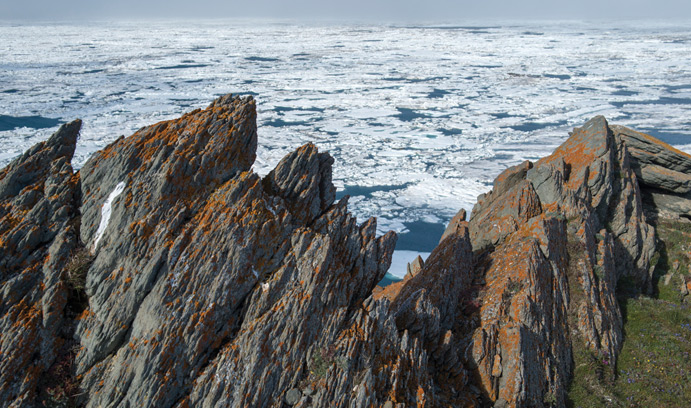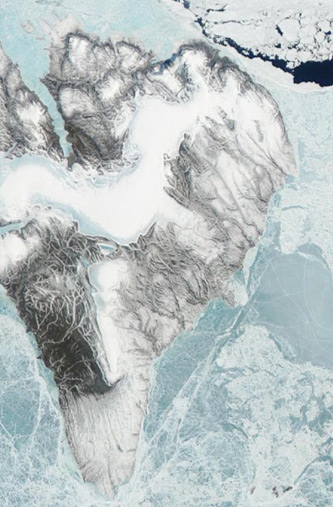Earth and Environmental Sciences: A Sharper Image of Climate Change

Ramage uses satellite data (right) to examine glaciers on the archipelagos of Novaya Zemlya and Severnaya Zemlya located north of continental Russia in the Arctic Ocean. (Photo by Sergey Gorshkov, courtesy of Corbis Images)
The Earth’s climate has changed throughout history. Most of these changes are attributed to very small variations in Earth’s orbit that change the amount of solar energy our planet receives. Yet, recent glacier research has shown that our planet is responding to changes in greenhouse gases, and those changes are happening quickly, geologically speaking. As the concern over global warming continues to grow, the work of Joan Ramage is providing insights about climate change in the Arctic.
Ramage, associate professor of earth and environmental sciences, studies changes in modern glaciers and seasonal changes in snow cover and how they are affected by climate. Funded by the National Aeronautics and Space Administration (NASA), Ramage uses satellite data to examine high arctic glaciers located on the Russian archipelagos of Novaya Zemlya and Severnaya Zemlya. These islands are located in one of the most rapidly changing areas in the world if gauging sea surface temperatures.
“The arctic is one of the fastest-changing parts of the world, and this area is fast for the Arctic,” she says.
Studying such a remote region of Russia prevents Ramage from conducting field work, so she examines melt dynamics and the interactions between glaciers, sea ice characteristics and weather using satellite data. For the past four years, she has used figures provided by Brigham Young University’s Microwave Earth Remote Sensing Laboratory to get a high-temporal resolution picture of climate change. These satellites measure microwave radiation, indicative of snow properties. Since the microwaves are capable of penetrating cloud cover and can be used at night, researchers are able to gather data that cannot be seen by the eye. Periods of freezing provide different signals than periods of melting, giving Ramage and her students a better understanding of glacier surface conditions.
“The holy grail of what you want to know is how much mass of ice has either melted or accumulated. You’re looking at the change in the accumulation compared to melt, evaporation or sublimation,” she says.
The data are showing that a number of glaciers in the region are changing rapidly and the change started recently. The satellite imagery gives researchers information about the glaciers’ daily melt dynamics, which provides important information about glacier and hydrological changes. Ramage’s research will document changes in seasons and the effects they have on other aspects of the environment. Her study showed the snow melt has been getting earlier and longer on Severnaya Zemlya. On Novaya Zemlya, the number of melt days also increased, but onset timing was highly variable. Ramage’s work also showed that as regional late summer sea ice extent declined, total melt days increased on both archipelagos, suggesting that sea ice loss might enhance glacier melt on Novaya Zemlya and Severnaya Zemlya by exposing larger open ocean water to evaporation or amplifying regional temperature through ice-albedo feedback and water vapor greenhouse effect. Shrinking sea ice is likely enhancing terrestrial ice snow melt in the Arctic.
Story by Robert Nichols
Posted on:


